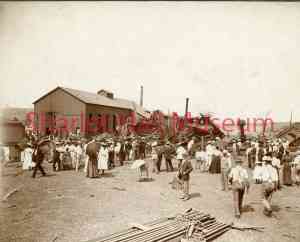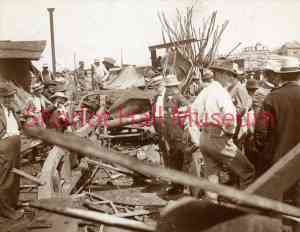By Mick Woodcock
This was the headline for an article in the Arizona Weekly Journal-Miner published on August 17, 1898. What followed was a detailed account of a locomotive boiler explosion on August 16 in the railroad yard on the north end of Prescott on the banks of Granite Creek.
 Today’s Depot Marketplace was originally the railyard for the Santa Fe, Prescott and Phoenix Railway. The current depot having not been built, the depot at the time was a one-story frame structure 150 feet long that housed offices, a waiting room and baggage storage. Cortez Street ended just short of the depot. Beyond it was the wood water tank that held 50,000 gallons of water to replenish the supply carried in steam engine tenders. Next to this was the two-stall wood roundhouse where locomotives were repaired.
Today’s Depot Marketplace was originally the railyard for the Santa Fe, Prescott and Phoenix Railway. The current depot having not been built, the depot at the time was a one-story frame structure 150 feet long that housed offices, a waiting room and baggage storage. Cortez Street ended just short of the depot. Beyond it was the wood water tank that held 50,000 gallons of water to replenish the supply carried in steam engine tenders. Next to this was the two-stall wood roundhouse where locomotives were repaired.
This unassuming structure was the scene of a boiler explosion that killed two men and seriously injured two others. Quoting the newspaper, “the wounded are: Joseph Brown, machinist, badly cut and crushed about the head. His death is expected at any moment. F. M. Seaman, day hostler, left arm blown off, left leg broken, and burned and cut about the head, resulting in his death within an hour after the accident. C. C. Chambers, railroad engineer, badly burned, cut and bruised. W. E. Madden, Gus Barth, Wilmot Pentland, Jess Simon and Henry Klotz were all in the roundhouse at the time of the accident, but miraculously escaped without injury.”
It turned out that Chambers was not as badly injured as thought and Barth, reported as having escaped injury, was hit in the back by flying debris and was still unable to get around a week after the accident.
 The exact cause of the explosion was not determined. Apparently, Brown was working on engine Number 2, which had a head of steam up. One witness said he was on top of the boiler adjusting the blow off valve while others indicated he was working on adjusting an air pump. Whatever caused the explosion, it completely destroyed the roundhouse. The engine itself was torn apart, with drive wheels blown off their axles and the 200-pound steam pump sent sailing three blocks into town. Bolts and other debris were found on the courthouse plaza, and twisted pipes and other wreckage littered the north end of Prescott.
The exact cause of the explosion was not determined. Apparently, Brown was working on engine Number 2, which had a head of steam up. One witness said he was on top of the boiler adjusting the blow off valve while others indicated he was working on adjusting an air pump. Whatever caused the explosion, it completely destroyed the roundhouse. The engine itself was torn apart, with drive wheels blown off their axles and the 200-pound steam pump sent sailing three blocks into town. Bolts and other debris were found on the courthouse plaza, and twisted pipes and other wreckage littered the north end of Prescott.
 The largest piece of wreckage to make it out of the railyard was the outside of the boiler and steam chest, which was estimated to weigh between four and five tons. It traveled about 1200 feet, landing in the Bashford-Burmister warehouse across from the Catholic Church, where the Social Security Office is today. Two men were standing in front of the church, talking. One reported seeing a large piece of iron rise from the ground and head right for them. He then heard the sound of the explosion. The mass of iron landed within fifty feet of them, narrowly missing a wagon traveling down Alarcon Street.
The largest piece of wreckage to make it out of the railyard was the outside of the boiler and steam chest, which was estimated to weigh between four and five tons. It traveled about 1200 feet, landing in the Bashford-Burmister warehouse across from the Catholic Church, where the Social Security Office is today. Two men were standing in front of the church, talking. One reported seeing a large piece of iron rise from the ground and head right for them. He then heard the sound of the explosion. The mass of iron landed within fifty feet of them, narrowly missing a wagon traveling down Alarcon Street.
Most of the force of the blast seemed to be directed towards town, with minor damage reported to other structures in the railyard. Next week we will find out what that damage was and what happened to the flying steam pump.
"Days Past” is a collaborative project of the Sharlot Hall Museum and the Prescott Corral of Westerners International (www.prescottcorral.org). This and other Days Past articles are also available at archives.sharlothallmuseum.org/articles/days-past-articles/1. The public is encouraged to submit proposed articles and inquiries to dayspast@sharlothallmuseum.org. Please contact SHM Research Center reference desk at 928-445-3122 Ext. 2, or via email at archivesrequest@sharlothallmuseum.org for information or assistance with photo requests.


